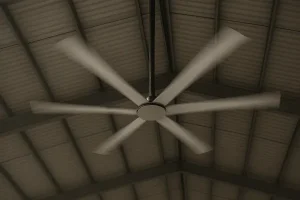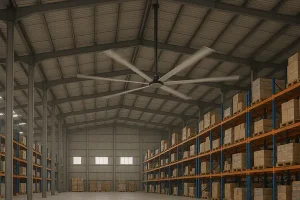At our HVLS fans manufacturing plant, we understand the frustration of stuffy work floors and rising energy expenses. That’s the problem. It can feel overwhelming. The solution? Harness an HVLS fan to transform conditions, reduce energy consumption, and keep everyone productive without breaking the bank.
An HVLS(high volume low speed) fan is a type of fan designed to circulate air at low speeds, yet move large volumes of air. By using wide-diameter blades—often greater than 7 feet—these fans work to improve air circulation for a comfortable environment, energy efficiency, and smoother air movement.

hvls fan in action
When thinking about indoor air circulation, we want solutions that cut down stagnant air, enhance air quality, and improve the overall working environment. HVLS fans are an effective way to achieve this. A fan is a type of mechanical fan that pushes a high volume of air at low speeds, redistributing warm air from the ceiling and drawing in cooler air near the floor.
Because HVLS fans are generally ceiling installations, they help move air evenly throughout large indoor areas. They give you many benefits in big venues such as a warehouse, distribution center, factories, and more. One of the many advantages is how they lower energy costs through reduced reliance on air conditioning.
A high-volume low-speed fan uses an expanded blade span to move large volumes of air at a leisurely rotation. This action drives down hot air that accumulates near the ceiling, allowing cooler air at low levels to rise and mix with the warm layers. By avoiding the frantic rotation of traditional high-speed fans, you get consistent airflow without an overwhelming breeze. Instead, you can maintain a steady air movement that reduces energy consumption.
When HVLS fans move air efficiently, they minimize how often your HVAC system must cycle. In colder seasons, they help recirculate warm air from overhead, assisting in heating and cooling balance. In turn, you experience cost savings year-round. Our own case studies at the HVLS fans manufacturing facility revealed up to 30% decreased heating bills in winter and a more comfortable summer. This approach is cost-effective for those aiming to slash utility bills.
Productivity is crucial in industrial and commercial environments. People work best when they can focus on tasks, not uncomfortably hot or stuffy conditions. Fortunately, HVLS fans are industrial solutions that fans can create a noticeable difference in climate. Workers enjoy stable temperatures, and air at low speeds can flow across the entire floor to minimize sweat and fatigue.
Fans help to maintain comfortable, consistent ventilation. As a result, employees in a warehouse or manufacturing facility stay energized. The benefits of HVLS fans also include fostering a more pleasant environment so that morale stays high, especially in large industrial spaces.
An HVLS fan—sometimes called a high-volume low-speed fan—is typically a fan greater than 7 feet in diameter. Traditional ceiling fan models, including residential ceiling fans, rarely exceed 5 feet. The longer blades allow HVLS fans to distribute large amounts of air throughout big facilities, whereas standard traditional ceiling fans only effectively cover smaller rooms.
Compared to traditional high-speed fans, HVLS technology is more energy efficient because it achieves the same (or better) cooling effect with fewer RPMs. With an HVLS fan, you keep the breeze gentle but widespread. This broad coverage eliminates stagnant air pockets in corners or high ceilings.
Maintaining good air quality ensures a healthy workforce and ideal working conditions. By installing industrial fans that continuously circulate air, you remove impurities that can linger in static zones. Reduced airborne dust and odors mean fewer respiratory irritations and a more pleasant space.
Fans are an effective solution to your ventilation goals, particularly in large spaces like hangars, gymnasiums, or a warehouse. Because fans are designed to operate at low speeds, they can run longer without becoming intrusive. Their broad coverage fosters a uniform distribution of fresh air from the outside.

hvls fan in a large warehouse
Fans work by taking air from the ceiling level and blending it with floor-level air. Through gradual but consistent blade rotations, the fan performance is optimized to maintain a balanced, comfortable environment. This technology, known as high-volume low-speed, relies on physics: lower blade speed combined with a larger surface area of the blades helps push the air gently downward and outward across floors.
Yes, a commercial HVLS fan is an excellent resource for balancing temperatures in a warehouse or distribution center. Warehouses often house tall racks, overhead beams, and large square footage that trap warm layers at the top.
“One of the many advantages of using an HVLS fan is a type of solution that suits huge, open areas with changing temperatures.”
By enhancing climate control, you reduce strain on your HVAC system. That means less stress on equipment, fewer maintenance calls, and improved occupant comfort. The result is maximum comfort and energy savings for your employees and visitors.
You might associate fans solely with summer, but HVLS fans can also help during winter. As hot air accumulates near the ceiling, an HVLS fan gently pushes that warm air down. This can lower your heating costs since you won’t lose so much expensive heat near the top of your building. Conversely, in summer, you can combine an HVLS setup with minimal air conditioning for a cooler interior.
In each scenario, operate at low speeds to optimize comfort. Studies estimate that you can reduce perceived temperature by 5°F to 8°F in summer and save on heating bills by 20% or more in winter. HVLS fans are an effective ally for year-round heating and cooling.
An HVLS fan typically needs adequate clearance from overhead supports. Greater than 7 feet from the ground is essential. In fact, fans installed in industrial facilities typically hang below rafters, but must remain high enough to meet safety codes.
A high-volume low-speed fan can vary from 7 to 24 feet in diameter. Choose the size that will effectively cover your square footage while meeting local regulations. Always factor in floor layout, shelving, or other equipment that could obstruct airflow.
HVLS fans are industrial behemoths, but that doesn’t limit them only to manufacturing sites. They thrive in:
They circulate air gently, offering energy savings and a more welcoming vibe. Indeed, the best hvls fans significantly improve conditions for employees and clients alike. They also reflect brand commitment to eco-friendly, cost-effective solutions.

The best fans at the sports center
To illustrate further, here’s a simple comparison table of typical fan performance factors for HVLS vs. smaller traditional ceiling fan setups:
| Feature | HVLS Fan | Traditional Ceiling Fan |
|---|---|---|
| Blade Diameter | 7 to 24+ ft. | Usually under 5 ft. |
| Airflow Coverage | Wide, encompassing up to thousands of square feet | Limited to smaller rooms |
| Energy Consumption | Lower, can save on energy costs | Higher, especially for large spaces |
| Maintenance & Lifespan | Long lifespan with minimal upkeep | Varies, more frequent replacements for heavy usage |
| Use Cases | Warehouse, factories, gymnasiums, commercial floorspaces | Residential or small business |
Case Study Example
We recently installed an HVLS fan in a 60,000-square-foot distribution center that previously relied on floor fans and traditional high-speed fans. Workers complained about intense heat in summer and uneven warmth in winter. After integrating an HVLS setup:
Are HVLS fans suitable for residential spaces?
Yes, though HVLS fans are industrial in design, they can be adapted if you have ample space. However, residential ceiling fans usually suffice for smaller living areas.
How does an HVLS fan compare to standard high-speed fans in terms of noise?
They typically run more quietly because they operate at a low speed and produce a steady hum instead of a loud chopping sound.
Do HVLS fans require special wiring?
Usually, standard commercial wiring works, but consult local electrical codes and a professional installer to confirm the specifics for your building.
What size HVLS fan should I install?
This depends on your building dimensions, layout, and overhead clearance. A fan greater than 7 feet suits midsize facilities. For larger facilities, you might pick blades up to 24 feet.
Can HVLS fans help with both heating and cooling?
Absolutely. HVLS fans can also push down hot air in winter, balancing interior temperatures and lowering heating expenses. They complement air conditioning in summer.
We specialize in creating fans designed for factories, commercial buildings, sports centers, gyms, schools, warehouses, and manufacturing facilities. Our fan is a type of commercial fan built for robust performance, energy savings, and ultimate reliability. We see ourselves not just as manufacturers but as partners in improving your working environment. If you have any concerns about air at low speeds, climate control, or how fans can also function with existing setups, we’re here to guide you.
“We aim to create a comfortable environment so your team thrives.”
An HVLS fan spins gently, yet fans produce a continuous breeze that breaks up large pockets of air in your facility. This helps improve air circulation by preventing overly hot or cold layers. Whether you run a busy distribution center, a bustling sports hall, or a dynamic industrial workshop, an HVLS installation is your solution to your ventilation puzzle.
If you’re searching for the best hvls fans or want help in creating a comfortable environment in large industrial spaces, we’re ready to assist. We have the background, the advanced technology, and a passion for innovation that ensures you get an HVLS setup that meets every requirement. Get in touch with us to transform your facility’s airflow dynamics today.
Feel free to reach out for a thorough assessment of your facility. We’ll help design and install an HVLS fan system that enables you to create a comfortable environment, cut down operational costs, and keep everyone satisfied. Our goal is simple: provide a cost-effective, sustainable way to ensure optimal airflow and ventilation in your space.

Hi, I’m Michael Danielsson, CEO of Vindus Fans, with over 15 years of experience in the engineering and design industry. I’m here to share what I’ve learned. If you have any questions, feel free to contact me at any time. Let’s grow together!